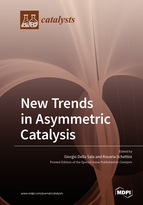New Trends in Asymmetric Catalysis
A special issue of Catalysts (ISSN 2073-4344). This special issue belongs to the section "Catalysis in Organic and Polymer Chemistry".
Deadline for manuscript submissions: closed (31 August 2020) | Viewed by 45655
Special Issue Editors
Interests: stereoselective organocatalyzed and metal-catalyzed reactions; enantioselective synthesis; phase–transfer catalysis; macrocyclic catalysts; synthesis and applications of cyclic peptoids
Special Issues, Collections and Topics in MDPI journals
Interests: synthesis of cyclic peptoids and their derivatives; phase-transfer catalysts; asymmetric synthesis; macrocyclic catalysts; biological applications; MRI contrast agents
Special Issues, Collections and Topics in MDPI journals
Special Issue Information
Dear Colleagues,
The ever-increasing demand of enantiopure or enantioenriched chiral molecules in diverse industrial sectors, such as the pharmaceutical, agrochemical, cosmetic, food chemistry and material science, has determined the flourishing of asymmetric synthesis throughout the past half century. In this respect, asymmetric catalysis is widely recognized as the ideal strategy for enantioselective synthesis, since, as a matter of principle, only a small amount of nonracemic chiral catalysts is generally needed to yield a large amount of nonracemic chiral product, resulting in a convenient multiplication of chirality. This concept has economic implications that make it especially appealing for industrial applications. On this basis, asymmetric catalysis, which is founded on three main pillars—metal-catalysis, organocatalysis, and biocatalysis—has grown explosively during the last few decades, and continual developments can be witnessed in this active research area. An impressive number of enantioselective transformations and efficient catalysts have been reported to date. Despite this, most of the them are amenable to improvement, especially for industrial applications. Current efforts are devoted to the rational design of novel chiral catalyst architectures in order to improve the enantioselectivity of known processes, as well as to expand the scope of asymmetric transformations. In addition, other criteria should be considered, such as product selectivity, turnover number and frequency, availability and cost of precursors, ease of preparation, environmental impact, and the possibility of recycling.
This Special Issue aims to cover recent advances in various aspects of asymmetric catalysis, including design and application of novel catalysts (metal compounds, organocatalysts, peptide derivatives, phase-transfer agents), mechanistic studies of enantioselective processes, innovative organic transformations, and others. Research articles, short communications, brief reports, and review papers on this topic are welcomed.
Dr. Giorgio Della Sala
Dr. Rosaria Schettini
Guest Editors
Manuscript Submission Information
Manuscripts should be submitted online at www.mdpi.com by registering and logging in to this website. Once you are registered, click here to go to the submission form. Manuscripts can be submitted until the deadline. All submissions that pass pre-check are peer-reviewed. Accepted papers will be published continuously in the journal (as soon as accepted) and will be listed together on the special issue website. Research articles, review articles as well as short communications are invited. For planned papers, a title and short abstract (about 100 words) can be sent to the Editorial Office for announcement on this website.
Submitted manuscripts should not have been published previously, nor be under consideration for publication elsewhere (except conference proceedings papers). All manuscripts are thoroughly refereed through a single-blind peer-review process. A guide for authors and other relevant information for submission of manuscripts is available on the Instructions for Authors page. Catalysts is an international peer-reviewed open access monthly journal published by MDPI.
Please visit the Instructions for Authors page before submitting a manuscript. The Article Processing Charge (APC) for publication in this open access journal is 2700 CHF (Swiss Francs). Submitted papers should be well formatted and use good English. Authors may use MDPI's English editing service prior to publication or during author revisions.
Keywords
- Chiral catalysts
- Chiral ligands
- Enantioselectivity
- Asymmetric organocatalysis
- Enantioselective industrial processes
- Asymmetric metal catalysis
- Asymmetric phase–transfer catalysis
- Enantioselective enzyme-catalyzed reactions
- Kinetic resolution
- Supported chiral catalysts







